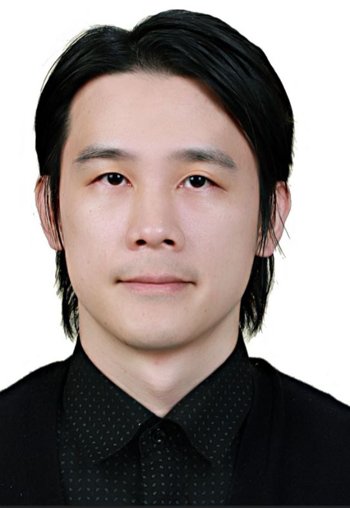Saw-less radio receivers in cmos
Yuan-Ching Lien is a PhD student in the research group Integrated Circuit Design (ICD). His supervisor is prof.dr.ir. B. Nauta from the faculty of Electrical Engineering, Mathematics and Computer Science.
 Smartphones play an essential role in our daily life. Connected to the internet, we can easily keep in touch with family and friends, even if far away, while ever more apps serve us in numerous ways. To support all of this, higher data rates are needed for ever more wireless users, leading to a very crowded radio frequency spectrum. To achieve high spectrum efficiency while reducing unwanted interference, high-quality band-pass filters are needed. Piezo-electrical Surface Acoustic Wave (SAW) filters are conventionally used for this purpose, but such filters need a dedicated design for each new band, are relatively bulky and also costly compared to integrated circuit chips. Instead, we would like to integrate the filters as part of the entire wireless transceiver with digital smartphone hardware on CMOS chips. The research described in this thesis targets this goal.
Smartphones play an essential role in our daily life. Connected to the internet, we can easily keep in touch with family and friends, even if far away, while ever more apps serve us in numerous ways. To support all of this, higher data rates are needed for ever more wireless users, leading to a very crowded radio frequency spectrum. To achieve high spectrum efficiency while reducing unwanted interference, high-quality band-pass filters are needed. Piezo-electrical Surface Acoustic Wave (SAW) filters are conventionally used for this purpose, but such filters need a dedicated design for each new band, are relatively bulky and also costly compared to integrated circuit chips. Instead, we would like to integrate the filters as part of the entire wireless transceiver with digital smartphone hardware on CMOS chips. The research described in this thesis targets this goal.
It has recently been shown that N-path filters based on passive switched-RC circuits can realize high-quality band-select filters on CMOS chips, where the center frequency of the filter is widely tunable by the switching-frequency. As CMOS downscaling following Moore’s law brings us lower clock-switching power, lower switch on-resistance and more compact metal-to-metal capacitors, N-path filters look promising. This thesis targets SAW-less wireless receiver design, exploiting N-path filters. As SAW-filter are extremely linear and selective, it is very challenging to approximate this performance with CMOS N-path filters. The research in this thesis proposes and explores several techniques for extending the linearity and enhancing the selectivity of N-path switched-RC filters and mixers, and explores their application in CMOS receiver chip designs.
First the state-of-the-art in N-path filters and mixer-first receivers is reviewed. The requirements on the main receiver path are examined in case SAW-filters are removed or replaced by wideband circulators. The feasibility of a SAW-less Frequency Division Duplex (FDD) radio receiver is explored, targeting extreme linearity and compression requirements. A bottom-plate mixing technique with switch sharing is proposed. It improves linearity by keeping both the gate-source and gate-drain voltage swing of the MOSFET-switches rather constant, while halving the switch resistance to reduce voltage swings. A new N-path switch-RC filter stage with floating capacitors and bottom-plate mixer-switches is proposed to achieve very high linearity and a second-order voltage-domain RF-bandpass filter around the LO frequency. Extra out-of-band (OOB) rejection is implemented combined with V-I conversion and zero-IF frequency down-conversion in a second cross-coupled switch-RC N-path stage. It offers a low-ohmic high-linearity current path for out-of-band interferers. A prototype chip fabricated in a 28 nm CMOS technology achieves an in-band IIP3 of +10 dBm , IIP2 of +42 dBm, out-of-band IIP3 of +44 dBm, IIP2 of +90 dBm and blocker 1-dB gain-compression point of +13 dBm for a blocker frequency offset of 80 MHz. At this offset frequency, the measured desensitization is only 0.6 dB for a 0-dBm blocker, and 3.5 dB for a 10-dBm blocker at 0.7 GHz operating frequency (i.e. 6 and 9 dB blocker noise figure). The chip consumes 38-96 mW for operating frequencies of 0.1-2 GHz and occupies an active area of 0.49 mm2.
Next, targeting to cover all frequency bands up to 6 GHz and achieving a noise figure lower than 3 dB, a mixer-first receiver with enhanced selectivity and high dynamic range is proposed. Capacitive negative feedback across the baseband amplifier serves as a blocker bypassing path, while an extra capacitive positive feedback path offers further blocker rejection. This combination of feedback paths synthesizes a complex pole pair at the input of the baseband amplifier, which is up-converted to the RF port to obtain steeper RF-bandpass filter roll-off than the conventional up-converted real pole and reduced distortion. This thesis explains the circuit principle and analyzes receiver performance. A prototype chip fabricated in 45 nm Partially Depleted Silicon on Insulator (PDSOI) technology achieves high linearity (in-band IIP3 of +3 dBm, IIP2 of +56 dBm, out-of-band IIP3 = +39 dBm, IIP2 = +88 dB) combined with sub-3 dB noise figure. Desensitization due to a 0-dBm blocker is only 2.2 dB at 1.4 GHz operating frequency.
Finally, to demonstrate the performance of the implemented blocker-tolerant receiver chip designs, a test setup with a real mobile phone is built to verify the sensitivity of the receiver chip for different practical blocking scenarios.





